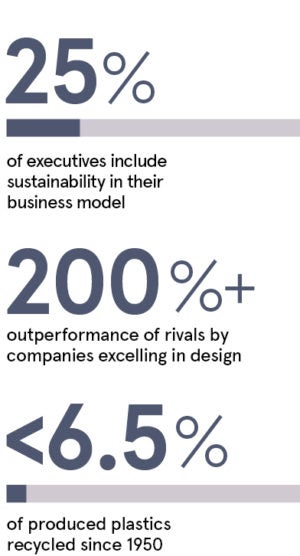It is now widely accepted that there is an environmental crisis gripping the Earth. Climate change affects people living across continents and is expected to worsen as the global population nears nine billion by 2050.
Product-makers have an urgent responsibility in helping ensure sustainability and they are increasingly doing so, motivated by the environmental challenge, customer preferences and, in some cases, regulation. But they need an all-encompassing approach.
“A lot of people still think of sustainability in waste and recycling terms, but there is a whole picture of what is needed,” says Vincent De Smedt, founder of product design firm Edmire Design. “A full approach to sustainability involves those aspects, but also careful design, choice of materials, selection of manufacturing destinations, environmentally friendly transport, energy-saving usage and human aspects, such as suitable working conditions and pay. It is a complex challenge.”
Recently, Edmire Design evolved its strategy to focus on projects with a sustainable approach. It began by working on its own transformation and it is now pursuing BCorporation.net certification, which demonstrates positive purpose for the planet.
“As designers, we all have a responsibility around natural resources, energy consumption, transport, conditions and all aspects of sustainability,” he explains. Some of the company’s clients are moving towards a more circular model, in which product materials at the end of their life go back into production; an advanced change.
Typically, clients begin their sustainability journey by assessing the impact of every aspect of their products. “Each decision has a significant sustainability impact. For example, producing goods further away from home will entail transport challenges, though producing locally may be more expensive,” says Mr De Smedt.

Faced with this dilemma, some companies put up resistance. He notes: “They might want to produce a low quantity of cheap products, locally, but this is not necessarily achievable. A smarter approach is to look at what can change: can the products be more premium quality and price, or can the business model be changed to offer additional revenue streams?”
The answers to many of these questions are not necessarily as people would expect. “It’s important to see the whole picture; if a product has a long life cycle, then producing it further away from home has a lesser impact. But for something being replaced every few years, then there is a strong opportunity to produce premium goods locally,” Mr De Smedt explains.
Having decided on a sustainability strategy, companies need to work with the right partners. Many of the businesses working with Edmire Design are small to medium-sized enterprises (SMEs) and startups, a group for which achieving affordable sustainability is challenging given lower volumes of production.
“To help businesses succeed with sustainability, we have a very different business model from other design companies,” he says. Startups receive extensive design consulting to launch products, in return for a small stake in their business. For SMEs, too, all risk is removed, through a shared royalty model that allows for payment to the design firm only as the product’s sales grow.
“We’ve created a model that allows businesses, which we share values with, to become more sustainable in this way, without the risk and the high cost normally associated with research and design. Typically, they learn as they grow their sustainability and are able to create excellent, successful goods that no longer have a big detrimental impact,” says Mr De Smedt.
The opportunity for businesses to achieve sustainability is strong, but if the Earth’s product-makers do not urgently address this question, the future looks bleak. For small businesses, the time to act is now and success is very achievable.
To find out about sustainable design for your business please visit www.edmire.design





